Safeback SBX is a new technology developed in Norway that aims to prolong the survival of a buried avalanche victim by improving airflow around the victim’s face. As was discussed recently on The High Route, this is a valid concept for improving survival in an avalanche, and the SBX system is the first real innovation to enter the consumer space since airbags became widely available.
Following this year’s ISSW in Tromsø, Norway, Safeback sent us an SBX unit to play with, along with a new SBX compatible backpack from Raide Research . In this article, we provide a first look at the actual hardware, its usability, and integration with the backpack. This is not a review of the backpack itself, nor a field test of the system, as snow is just beginning to fall here around the 45th parallel.
You can find our prior coverage of the SBX concept here.
Concept
While airbag systems are largely wedded to backpacks, or a manufacturer’s family of packs, the SBX system is a standalone unit that can be migrated between SBX compatible packs, even of different manufacturers.
The SBX is a fan that brings air from the snowpack behind the user up to the shoulder straps via two hoses—the unit turns on when triggered by the handle.
To be Safeback ready, a pack must have a secure place to house the fan, routing into each shoulder strap, a mesh pouch on each shoulder strap, a mesh inlet near the base on the body of the pack, and it needs webbing mounts to tether both hoses and the trigger. This is to say that you can’t stick the unit into just any pack, it has to be a “Safeback Ready” design.
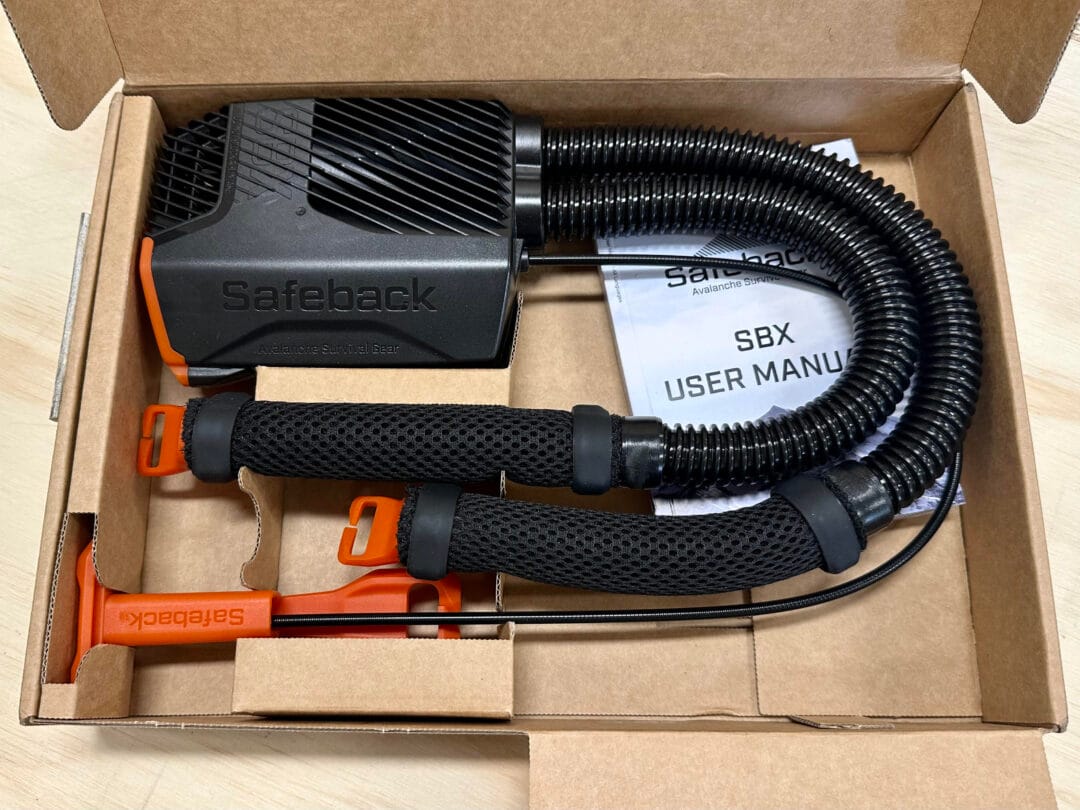
Design
The majority of the SBX system’s overall weight is in the base, where the fan unit, batteries, and electronic controller are housed. From this base emerge two stiff plastic hoses that end with a hotdog-sized mesh diffuser, each destined for one of the backpack straps. There is also a cable-actuated trigger that can be passed into either shoulder of the pack.
Aside from the trigger, there is only one switch on the base, which can be used to test the system, or to turn it off once triggered. The batteries for the unit are housed in a slide-out battery holder. A flathead screwdriver is needed to open the battery compartment, and the hold then accepts 6 Energizer Ultimate Lithium AAs. These are the only batteries spec’d; the manufacturer states that the “system is designed for them, so if you put in Alkaline AAs, it may give you a “Red” response recognizing the wrong batteries. Alkaline [batteries] are also heavier.”
The whole unit is quite light, 523g with batteries installed. It’s light enough that it almost feels like it must be a plastic mockup, but no, that’s just how much it weighs.
The Raide pack, considering a safety device is integrated into the design, does have considerably more usable space, and some features not available to airbag packs, like A-frame ski carry. Regardless, both the SBX system and its backpack integration are light.
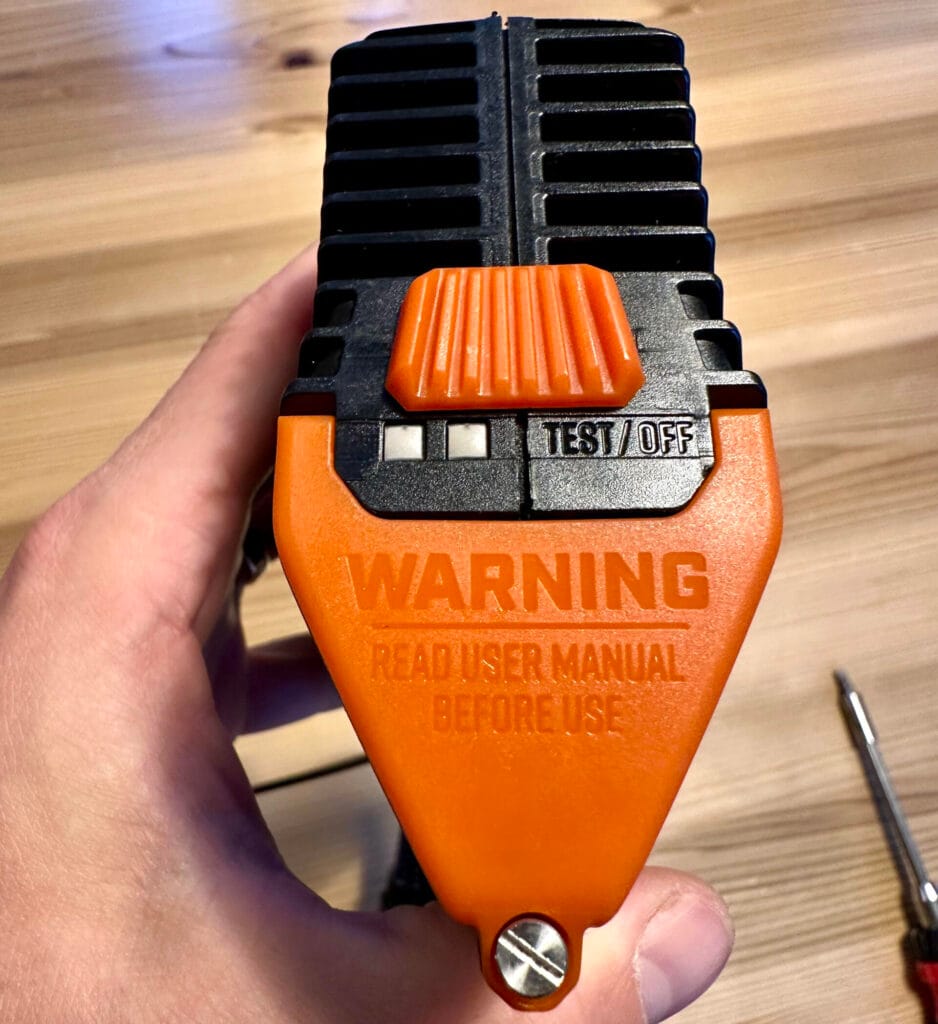
[et_pb_text content_tablet=”
Install
Installing the SBX into the Raide SBX pack was simple in concept and tricky in practice. The base of the unit has a zip cover made by Raide that protects the unit inside the pack. This zips over the unit leaving space for air intake and actuating the only switch. The unit and cover then sit very snugly into a small sleeve just behind the user’s left shoulder, inside the body of the pack.
The hoses are installed by sliding them into each shoulder strap via an interior opening akin to a hydration hose port, but with a bit more clearance. The hoses then live within a mesh pouch on each shoulder, and tether to a small sewn loop at the bottom of each pouch. The trigger can be routed down either shoulder and mounted to one of three positions depending on user size and preference.
The annoyances during the install began with the storage sleeve called a “drop pocket” sewn inside the Raide pack, which is unnecessarily snug, making it hard to install and remove the unit. Once in the sleeve, the velcro securing strap fixed on the sleeve seems to be in slightly the wrong place, but that’s of little concern. It’s not coming out of there.
Installing the hoses is easy, yet the plastic of the hoses does not like to twist. Once routed into the backpack straps, the clasps designed to tether them to the ends of the shoulder strap pouches don’t quite end up parallel to their webbing loops, so once attached, the shoulder strap deforms a bit as the hose tries to untwist itself, a minor annoyance that is improved when the pack is loaded.
” content_phone=”
Install
Installing the SBX into the Raide SBX pack was simple in concept and tricky in practice. The base of the unit has a zip cover made by Raide that protects the unit inside the pack. This zips over the unit leaving space for air intake and actuating the only switch. The unit and cover then sit very snugly into a small sleeve just behind the user’s left shoulder, inside the body of the pack.
The hoses are installed by sliding them into each shoulder strap via an interior opening akin to a hydration hose port, but with a bit more clearance. The hoses then live within a mesh pouch on each shoulder, and tether to a small sewn loop at the bottom of each pouch. The trigger can be routed down either shoulder and mounted to one of three positions depending on user size and preference.
The annoyances during the install began with the storage sleeve called a “drop pocket” sewn inside the Raide pack, which is unnecessarily snug, making it hard to install and remove the unit. Once in the sleeve, the velcro securing strap fixed on the sleeve seems to be in slightly the wrong place, but that’s of little concern. It’s not coming out of there.
Installing the hoses is easy, yet the plastic of the hoses does not like to twist. Once routed into the backpack straps, the clasps designed to tether them to the ends of the shoulder strap pouches don’t quite end up parallel to their webbing loops, so once attached, the shoulder strap deforms a bit as the hose tries to untwist itself, a minor annoyance that is improved when the pack is loaded.
%91caption id=%22attachment_15810%22 align=%22aligncenter%22 width=%221080%22%93 The Raide sleeve for the Safeback body.%91/caption%93
The Raide sleeve for the Safeback body.%91/caption%93
” content_last_edited=”on|phone” admin_label=”Install” _builder_version=”4.27.2″ _module_preset=”default” header_2_line_height=”1.2em” hover_enabled=”0″ text_font_size_tablet=”” text_font_size_phone=”16px” text_font_size_last_edited=”on|phone” global_colors_info=”{}” sticky_enabled=”0″]
Install
Installing the SBX into the Raide SBX pack was simple in concept and tricky in practice. The base of the unit has a zip cover made by Raide that protects the unit inside the pack. This zips over the unit leaving space for air intake and actuating the only switch. The unit and cover then sit very snugly into a small sleeve just behind the user’s left shoulder, inside the body of the pack.
The hoses are installed by sliding them into each shoulder strap via an interior opening akin to a hydration hose port, but with a bit more clearance. The hoses then live within a mesh pouch on each shoulder, and tether to a small sewn loop at the bottom of each pouch. The trigger can be routed down either shoulder and mounted to one of three positions depending on user size and preference.
The annoyances during the install began with the storage sleeve called a “drop pocket” sewn inside the Raide pack, which is unnecessarily snug, making it hard to install and remove the unit. Once in the sleeve, the velcro securing strap fixed on the sleeve seems to be in slightly the wrong place, but that’s of little concern. It’s not coming out of there.
Installing the hoses is easy, yet the plastic of the hoses does not like to twist. Once routed into the backpack straps, the clasps designed to tether them to the ends of the shoulder strap pouches don’t quite end up parallel to their webbing loops, so once attached, the shoulder strap deforms a bit as the hose tries to untwist itself, a minor annoyance that is improved when the pack is loaded.

The annoyances during the install began with the storage sleeve called a “drop pocket” sewn inside the Raide pack, which is unnecessarily snug, making it hard to install and remove the unit. Once in the sleeve, the velcro securing strap on the sleeve seems to be in slightly the wrong place, but that’s of little concern. It’s not coming out of there.
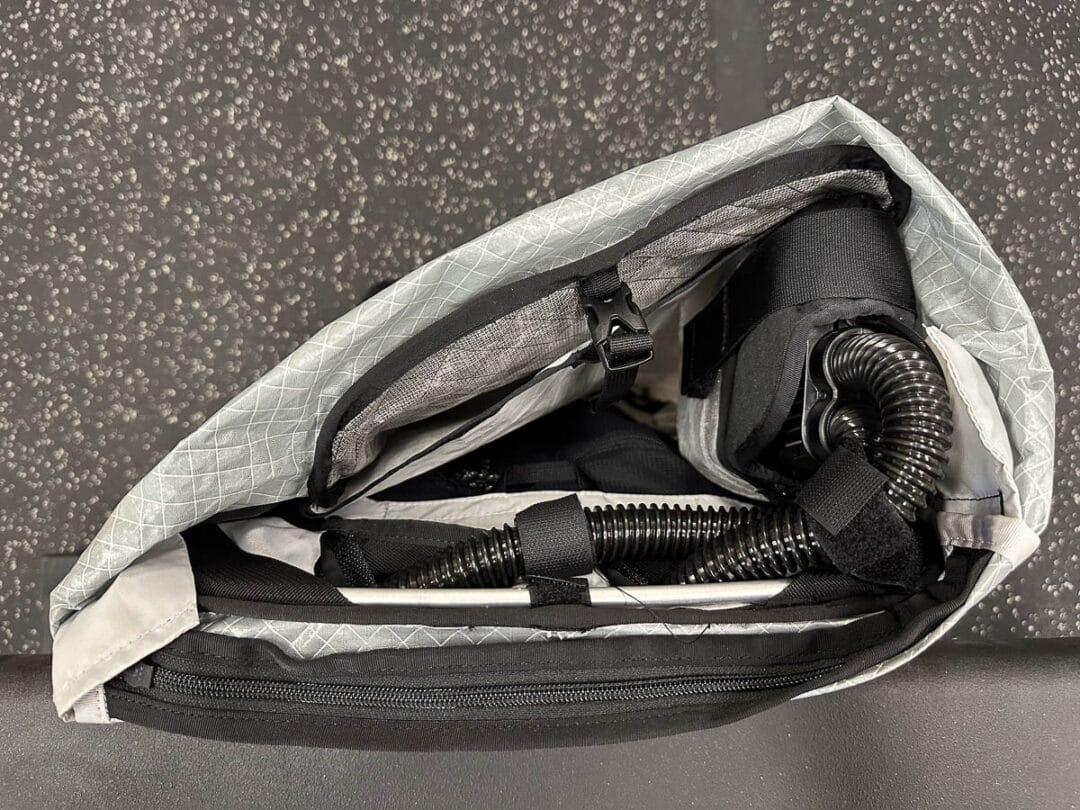
Installing the hoses is easy, yet the plastic of the hoses does not like to twist. Once routed into the backpack straps, the clasps designed to tether them to the ends of the shoulder strap pouches don’t quite end up parallel to their webbing loops, so once attached cause the shoulder strap to deform a bit as the hose tries to untwist itself, a minor annoyance that is improved when the pack is loaded.
Operation
Actuating the fan is as easy as one would hope. There is no need to turn the unit “on” to a ready state, and Safeback says that with trivial to no background power use, a single set of batteries will easily last a season if not triggered. With batteries in, the Safeback is ready to go when you pull the trigger. The trigger is also just a spring-loaded cable, so after each pull, it returns to a neutral position. It doesn’t need any kind of reset before it can be pulled again.
Once triggered, the fan turns on within about two seconds. The sound is akin to someone using a hairdryer in the next room with the door closed. It’s noticeable, but not annoying. With the fan on, a very faint breeze comes up towards the face from the backpack straps.
To turn the unit off, the user has to open the pack to access the drop sleeve and reach the SBX base unit. Once accessed, hold down the unit’s only switch and it turns off—ready to be used again as soon as the trigger is pulled.
I tested the unit’s runtime, which is advertised to be at least 90 minutes at -22F. I tested it with the spec’d lithium batteries, but inside and not beneath the snow. Cold weather should reduce the runtime. Given that the pack protects the fan intake from becoming occluded, burying the unit shouldn’t increase the power draw or reduce runtime, but this remains to be field-tested. In my living room test, the fan ran for more than 3 hours on a new set of batteries before I gave up trying to deplete it.
Initial Impressions and Critiques
I heard a quote recently that “you can judge the quality of an idea by how much you find yourself wishing that you’d come up with it yourself”. For me, this applies to the SBX concept, which is so simple, yet potentially effective.
My initial impression is that this is a high-quality concept in the early years of its implementation. It has some design flaws that I’m going to discuss, but I think that, barring some definitive demonstration of its uselessness, will become fairly widespread in use.
I think that the use cases posited by Safeback’s CMO, Will Sherman, are valid opportunities for this new technology:
“We continue to see success of SBX standalone in 3 areas:
-Ski touring where there is a huge gap between beacon use and airbag use
-Pro SAR – where rescuers working in runouts already communicate that they don’t use airbags due to the reduced lift effect when in the bottom of avalanche paths
-Powder tree skiing, where tree wells and SIS [snow immersion suffocation] are a concern.“
That said, with any new idea comes many chances to refine it. What follows are the significant upsides of the pack, followed by critiques that if rectified would, I think, greatly improve the adoption of the technology.
Upsides
Weight. The weight of the unit is almost trivial, even with batteries installed. If your primary excuse for avoiding an airbag pack has been complaints about weight, you can’t level those same complaints at the Safeback system. The weight is equivalent to a half liter of water, and when used with the Raide SB-30, offers one of the lightest safety-oriented packs on the market.
Usable volume. In comparison to even a carbon canister airbag system, the SBX uses very little internal volume (0.75L). The big win in comparison to the airbag is both at the canister level, but more importantly the pack does not need to house the bulky fabric of an airbag backpack. This 30L pack is damn near 30L in carrying capacity.
Design flexibility. Doing away with the need to have an unobstructed airbag zipper across both the sides and top of the pack opens the way for a number of pack design advantages:
-Both diagonal and A-frame ski carry.
-Top-loading packs that can be expanded for larger loads (roll top or 30+10 type designs).
-Ability to carry loads on top of the pack, like ropes.
-More options for avalanche tool access, such as a side-zip.
-The pack is generally more functional with the unit removed than a similar airbag backpack, and the full weight of the system comes out when removing the unit.
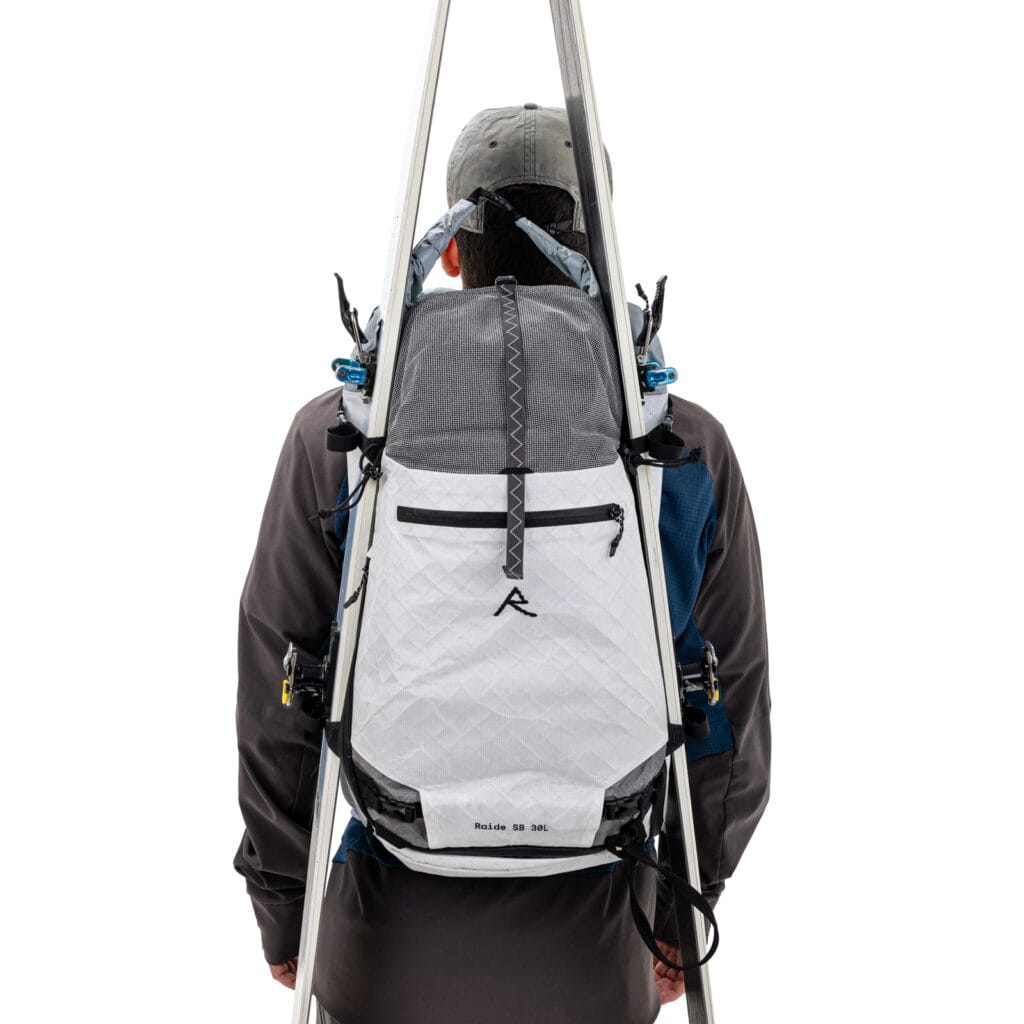
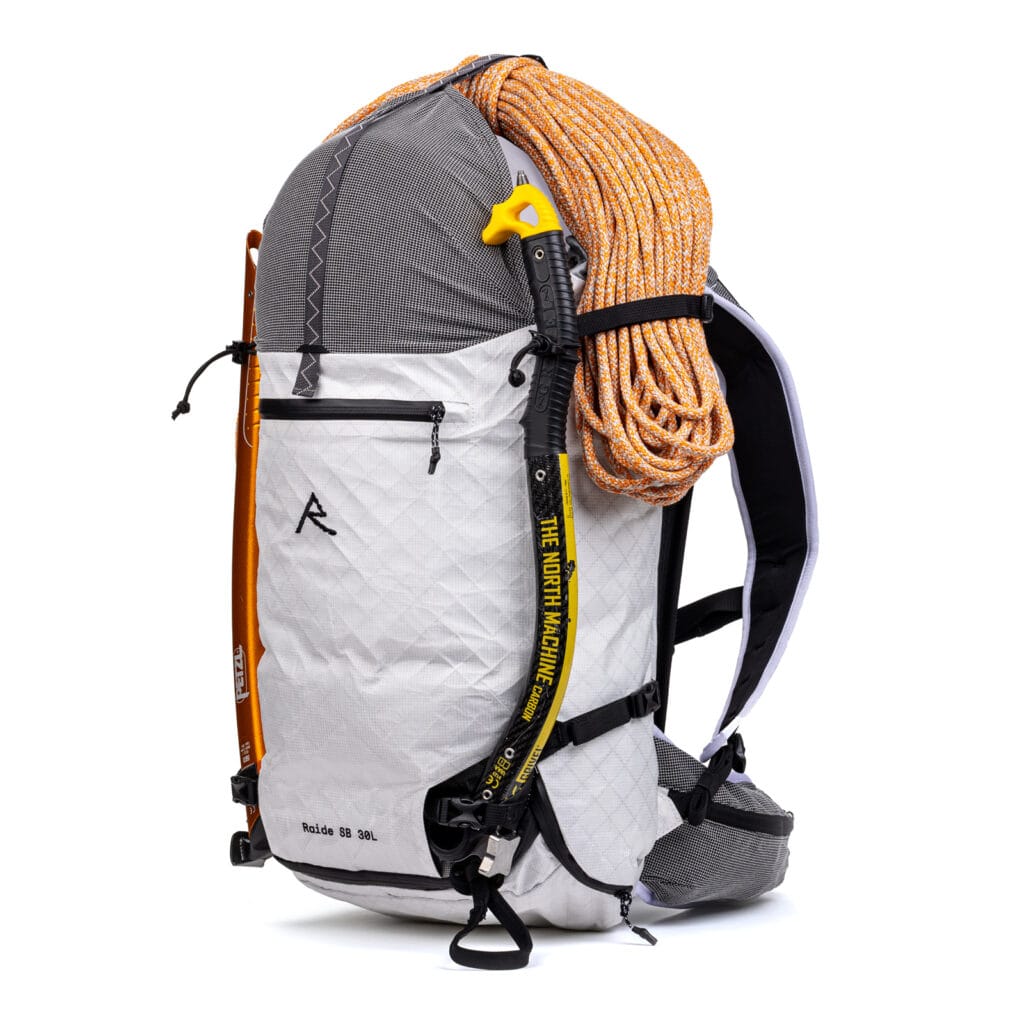
Improvements:
Batteries?! In 2025, this unit needs to have a rechargeable battery. The battery housing is not accessible when using the pack, requires an actual screwdriver to open, and uses some really expensive over the counter batteries ($2.50 per AA, takes 6). If the SBX is ever to be used by triggering it before skiing, then power will be used during every tour. Yet, one wants to start the tour with maximum battery. To be useful in fleet use (ski patrol, SAR), the unit needs to have a rechargeable battery that can be charged without removing the unit from the backpack. Safeback’s response to this critique is that these batteries provided best capacity and resistance to cold in comparison to standard alkaline AAs or rechargeable batteries, but I think they will have to bite the bullet and move to rechargeable to be widely viable.
Turning the unit off. You can’t turn it off without flipping the pack around and open the back panel access to do so. This means that in its current manifestation, SBX can be triggered to run at the top of a ski run preemptively but it is then cumbersome to turn it off at the end of the run. Doing do so requires 15-20 seconds to access the back panel and turn the unit off. The idea of activating before entering the run is one that was first presented to me by Safeback as a tactic employed by some professionals using the pack, and the idea of triggering preemptively is also included in Raide’s marketing materials.
I’d like to see a protected switch on the handle that allows you to test the unit and to turn it off. Safeback says that at ISSW they found it possible to actuate the off switch through the side of the backpack, which I confirmed, but it’s certainly not easy and requires taking the pack off at a minimum. It would be easier if the base unit was not housed in a protective sleeve that itself then goes into a sleeve. One sleeve would suffice.
Durability. I am concerned about the strength of the plastic used to attach the hoses to webbing loops in the shoulders and the trigger to the shoulder loop. While we haven’t field-tested the unit, they’re quite thin and I don’t think they’d hold up to removal/reinstallation over many migrations between packs. The Safeback is drop tested to the MIL-810G standard and they report no breakage of these points in the roughly 1000 units they have in the field so far. I’d like to see these replaced with an aluminum hook and snug webbing loop, as failure could result in the hose retracting away from the face. I am also concerned about the battery holder, which is made of very thin plastic, likely to break with battery changes. Get rid of the battery holder and that problem goes away.
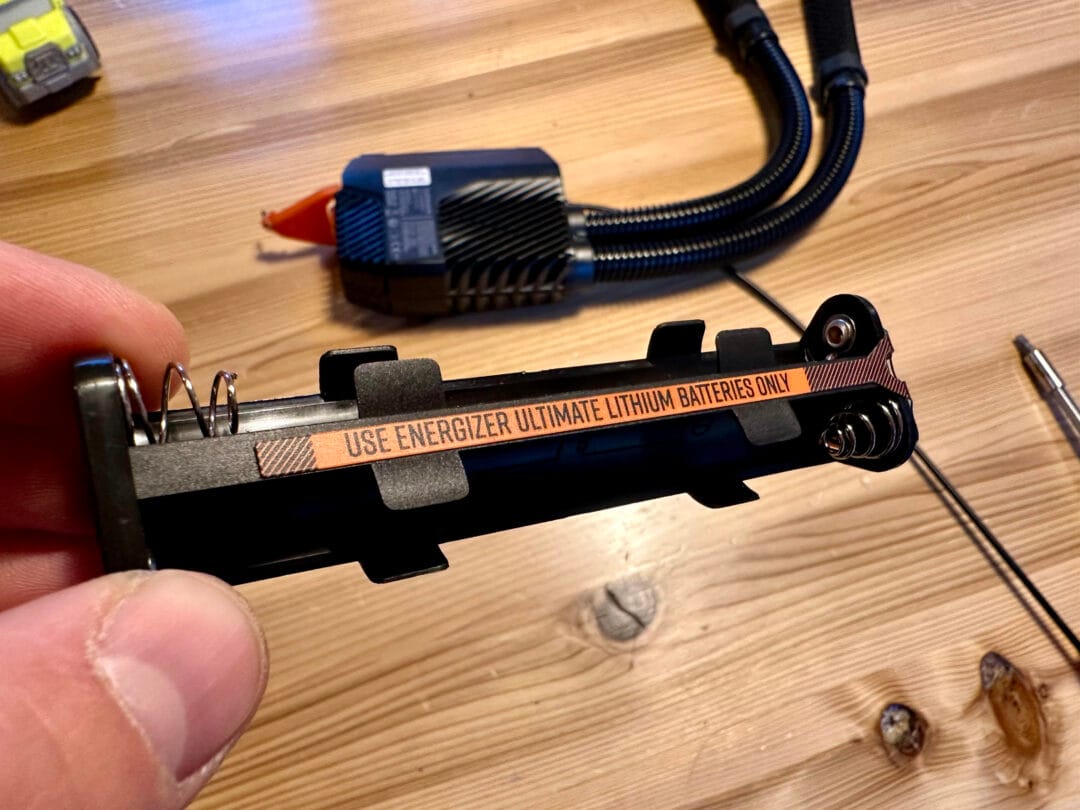
Pack Compromises. While having a backpack whose design is not dictated by the presence of an airbag does allow other useful features like A-frame carry, there are some compromises that arise from the Safeback integration as well. While little annoyances like the fit of the base unit into the Raide pack sleeve can evolve with iteration, it’s worth considering the use of the shoulder real estate for the SBX. I wonder whether it is possible to create a pack that both houses the SBX but allows better use of the shoulder straps. As designed into the Raide pack, there is no potential to mount a radio or radio mic on the shoulder, requiring the user to mount lower on the sternum strap ladder, placing the radio lower on the user’s chest and potentially closer to their avalanche beacon.
The Raide shoulder strap is half-elastic to accommodate whatever you can cram in there, and Safeback says that it’s ok to route a hydration hose and radio wire adjacent to the air hoses, but that space is going to get busy fast with two hoses, a hydration hose, radio wire, and trigger wire.
My other concern is the way the unit integrates with the pack. At least in the Raide implementation, the hoses are right there when you open the top of the pack and could catch on things going in and out of the pack. Safeback says that back panel access is intended to be the primary access, and that this avoids the hoses, but I question if most users will use the back panel access as the primary entry when both a roll top and a zipper give access to the top of the pack. Completely integrated routing would fix this, but Raide says it built this current integration to save weight.

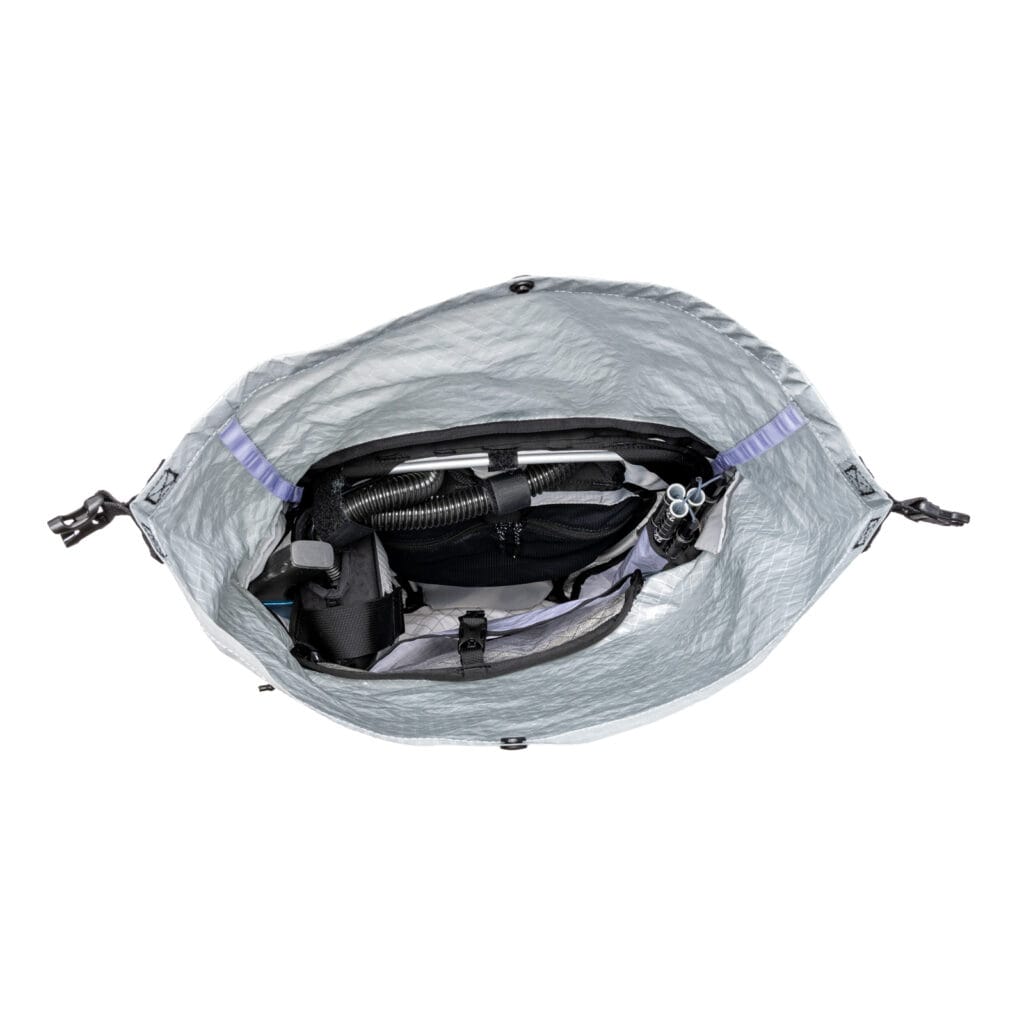
The Future
I think that the real future of the Safeback technology will be in two specific niches. First, I expect it to become integrated with existing airbag systems. This resolves the choice between airbags and the Safeback system and could also make airbag users safer. It stands to reason that electronic airbag systems could both inflate an airbag and use their fan to drive a Safeback ventilation system. Such a system could both reduce critical burials and mitigate their consequences.
Second, I see this being built into a vest platform for use by commercial outfits that largely guide within the tree line. Cat operators, for example, who could have clients use and deploy the device prior to runs, mitigating SIS risk and prolonging the available time to extricate them should they become buried.
The niche that Safeback can currently fill is for a user who balks at the weight of an airbag pack (though these weights are ever decreasing) but who wants to improve their margin of safety. I don’t see the edge that Safeback hopes will exist for a lot of SAR or rescuer use, as often backcountry rescuers either come from an adjacent ski area, and will be equipped with airbag backpacks, or they have to travel avalanche terrain in which an airbag is effective. Safeback says that the SAR groups they are targeting in Europe are often approaching from the bottom, and they would be better protected by the Safeback than by an airbag.
Bottom Line
The new Safeback SBX system has landed in the US in partnership with backpack manufacturers making Safeback ready packs. This first implementation has some small bugs that certainly don’t reduce its potential efficacy, but I do see potential for improvement in coming years and in partnership with airbag manufacturers. It is light and unobtrusive, and it’s likely to improve your survival if buried. Whether it makes more sense to carry Safeback than an airbag is an unanswered question. We will be testing both the pack and the Safeback in the field and will have more for you as the season progresses.

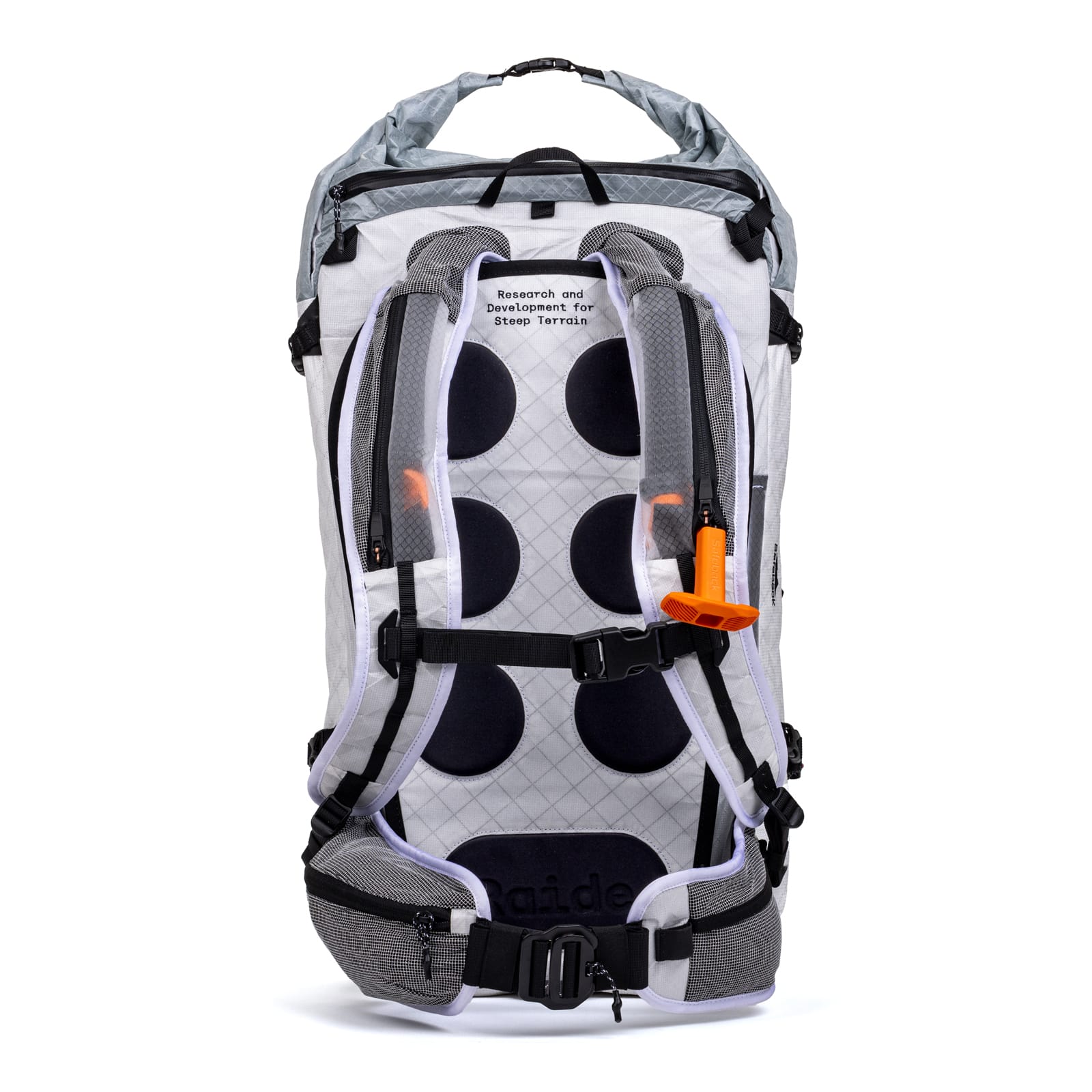
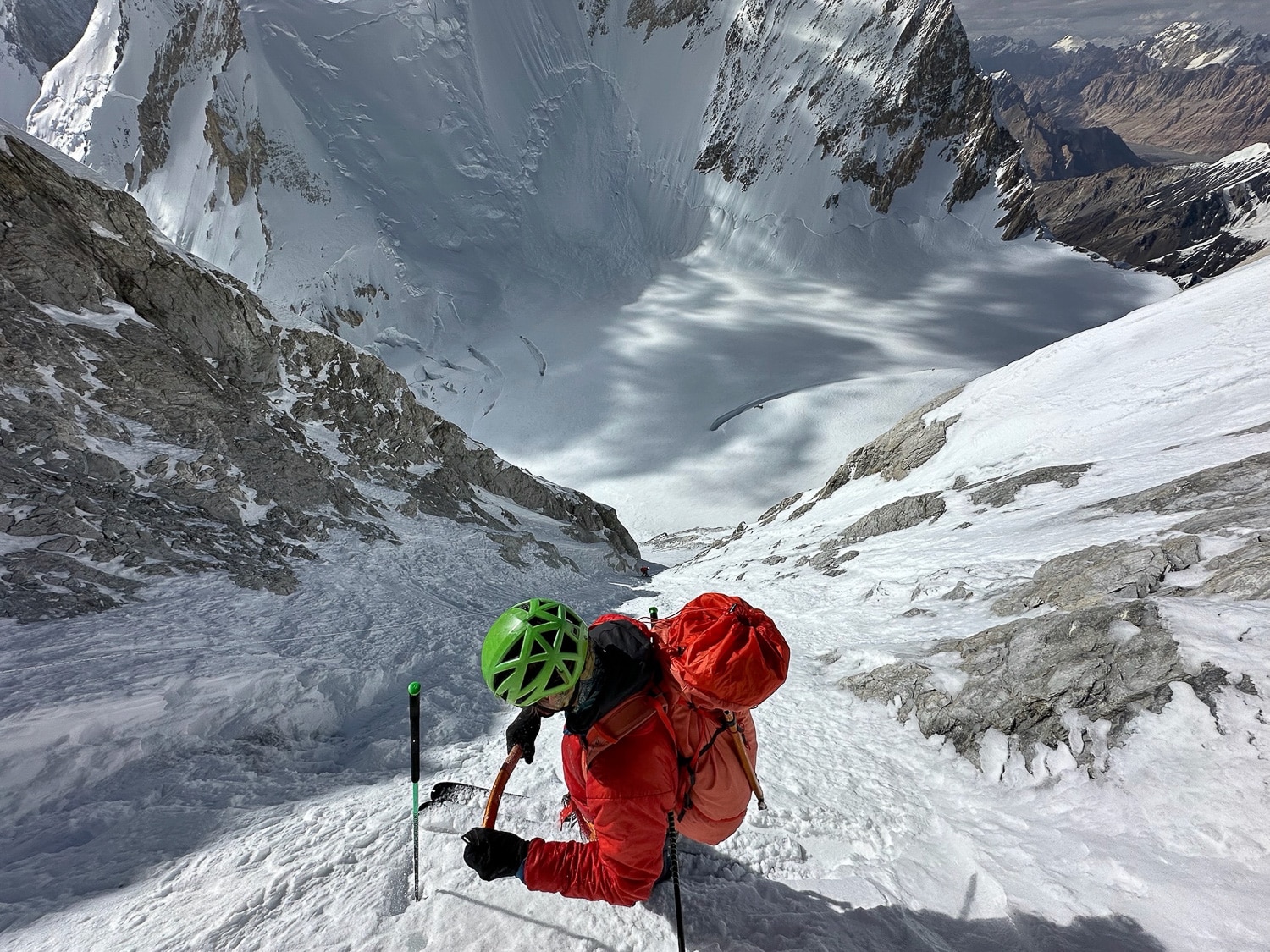



Leave a Reply
You must be logged in to post a comment.